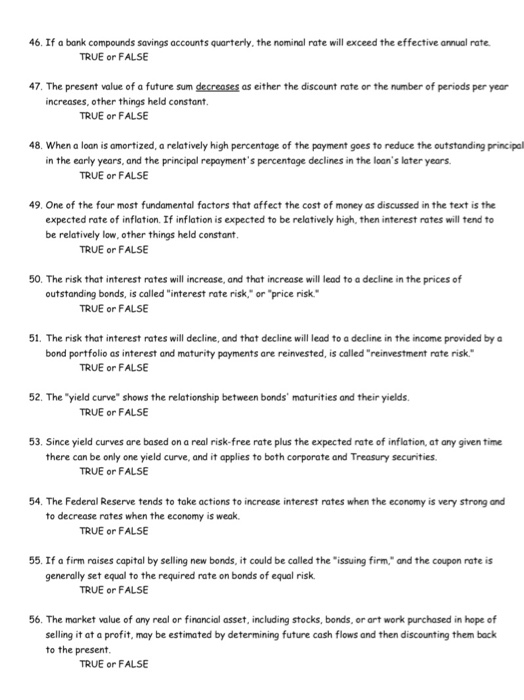46. If a bank compounds savings accounts quarterly, the nominal rate will exceed the effective annual rate. TRUE or FALSE 47. The present value of a future sum decreases as either the discount rate or the number of periods per year increases, other things held constant TRUE or FALSE 48. When a loan is amortized, a relatively high percentage of the payment goes to reduce the outstanding principal in the early years, and the principal repayment's percentage declines in the loan's later years. TRUE or FALSE 49. One of the four most fundamental factors that affect the cost of money as discussed in the text is the expected rate of inflation. If inflation is expected to be relatively high, then interest rates will tend to be relatively low, other things held constant TRUE or FALSE 50. The risk that interest rates will increase, and that increase will lead to a decline in the prices of outstanding bonds, is called "interest rate risk," or "price risk." TRUE or FALSE 51. The risk that interest rates will decline, and that decline will lead to a decline in the income provided by a bond portfolio as interest and maturity payments are reinvested, is called "reinvestment rate risk." TRUE or FALSE 52. The "yield curve" shows the relationship between bonds' maturities and their yields. TRUE or FALSE 53. Since yield curves are based on a real risk-free rate plus the expected rate of inflation, at any given time there can be only one yield curve, and it applies to both corporate and Treasury securities. TRUE or FALSE 54. The Federal Reserve tends to take actions to increase interest rates when the economy is very strong and to decrease rates when the economy is weak. TRUE or FALSE 55. If a firm raises capital by selling new bonds, it could be called the issuing firm," and the coupon rate is generally set equal to the required rate on bonds of equal risk. TRUE or FALSE 56. The market value of any real or financial asset, including stocks, bonds, or art work purchased in hope of Selling it at a profit may be estimated by determining future cash flows and then discounting them back to the present. TRUE or FALSE







